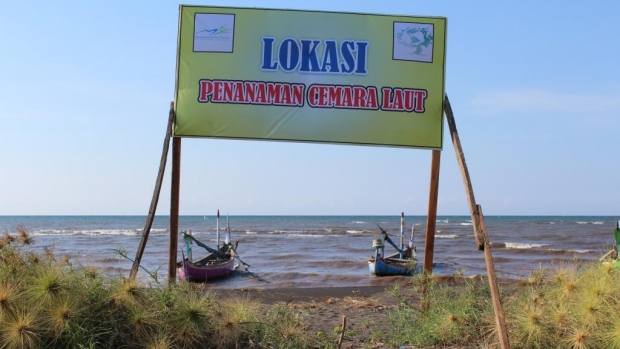Grants :: Small Grant Facilities :: Women’s Group Empowerment to Increase Household Income through Production and Marketing of Mangrove and Fisheries-Based Products in Karanganyar Village, Paiton
Women’s Group Empowerment to Increase Household Income through Production and Marketing of Mangrove and Fisheries-Based Products in Karanganyar Village, Paiton

Casuarina rehabilitation site, Karanganyar village, Paiton sub-district, Probolinggo District, East Java © MFF-Indonesia/Cynthia Nurcahya
Objectives
The project objective is to protect coastal area in Karanganyar from abrasion through coastal vegetation rehabilitation and livelihood activities.
Background
Karanganyar is one of the coastal villages located about 30 km to the east Probolinggo, East Java, which is populated majority by farmers and fishermen. Communities are living in poor condition and poverty become the major problem in this village. There are only few people who own fishing gears and farming equipment. Farmers and fishermen earn sufficient income only in the harvesting and fishing seasons. Because of this, their incomes are very low. This economic condition is worsened by environmental degradation and coastal abrasion occurring as an impact of climate change. Communities in this village were unaware of this issue. This situation has attracted the attention of LPPM-IAINJ, an organization under the Islamic Institute in Probolinggo, to work with local communities to solve the problem. Through the SGF project, LPPPM-IAINJ along with the local communities planted 1,150 Casuarina in the 5 ha of coastal area in Karanganyar Village and empowered community groups.
This project also attempts to deconstruct the social-cultural and build awareness of the urgency of women’s participation in addressing environmental issue through environmental conservation and income generating program. This is because male involvement in the public sphere and women in domestic sector is reality that has been accepted as a regular standard in this village; though women are often said have dual roles both in employment/entrepreneurial and domestic sectors. By this project, women groups will be empowered through income generating program, including (a) the production of grill milk fish cake (otak-otak bandeng); (b) the production of crab-cracker; (c) the production of batik from mangrove, and (e) product marketing.
Target beneficiaries
In total, direct beneficiaries engaged in this project are 67 people and indirect beneficiaries are approximately 1,779 people.
Outputs
LPPPM IAINJ had facilitated community groups consisting of men and women in planting 1,150 coastal vegetation (Casuarina) along the coastal area of Karanganyar Village. Communities were regularly looking after the seedlings by providing proper maintenance (i.e watering the seedlings twice a day).
In terms of investing income generation program, a women group had been trained to produce Otak-otak Bandeng (grill milk fish cake). The production of Otak-otak Bandeng has started in a small scale. To support product marketing, the group attempted to get a PIRT (Pangan Industry Rumah Tangga) or household industry permit from Public Health Office.
Accomplishments and challenges
 |
Contributions to cross-cutting themes
By planting 1,000 coastal vegetation there will be additional carbon sequestered that benefits to reduce Green House Gas (GHG) emission in the atmosphere. In addition, gender has been considered as priority in the project design and is reflected in project activities. The engagement of women in rehabilitation activity was clearly seen and the role between men and women is fairly balance. In the livelihood improvement program, community members involved are 100% women.
Lessons Learned
- The initiation of small scale businesses, training and followed by the production itself might take some time (going through some trials and errors). It is sometimes hard to estimate percentage of the benefit per month from the activities that instant, and the project period is also relatively short (10-12 months). The most reasonable outputs than can can be expected from these activities are knowledge sharing to the direct beneficiaries (groups involved) on how to process fish and other products to become commodities with more economic value and to build entrepreneurial spirit.
- While choosing the types of livelihood activities to be conducted, it is best to use participatory approach, where grantee has gone through consultation process with the communities as the implementers on the ground. In addition, it is important to identify the all supporting aspects related to the livelihood activities/small-scale business starting from the provission of the raw materials, production, marketing to the management of the profit generated and cash flow to ensure the sustainability of the business.
- Especially for the mangrove-based food training and production, grantee should make sure the availability of the mangrove species needed as the main ingredients/materials for the training and production in order to ensure sustainability of the business. It should be noted that not the all mangrove fruits, leaves and so forth can be harvested and available throughout the year.
Project Facts
Country
Location
Karanganyar Village, Paiton Probolinggo, East Java
Topic
Duration
2nd Mar 2016 to 31st Dec 2016
MFF Grant Amount
IDR 130,005,000
Co-financing Partner
In kind from others IDR 1,300,000 (USD 106.56)
In kind from Grantee IDR 8,450,000 (USD 692.62)
Implementing Partner
Lembaga Penerbitan, Penelitian, dan Pengabdian pada Masyarakat/Research, Publishing Centre and Community Service (LPPPM) - Nurul Jadid Islamic Institute (IAINJ)
PO. BOX. 1, Karanganyar, Paiton, Probolinggo - 67291, East Java
Contact person: Syamsuri/Project Manager
Phone/mobile: +6285236197421
Email address: lpppm.iainj@yahoo.com